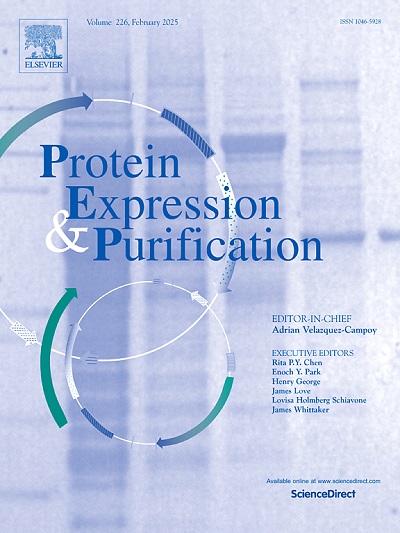Modulation of Glutamine Synthetase adenylylation by nitrogen availability enables one-step purification in distinct post-translational states
IF 1.2
4区 生物学
Q4 BIOCHEMICAL RESEARCH METHODS
引用次数: 0
Abstract
The glutamine synthetase (GS) enzyme pathway promotes ammonium assimilation in bacteria and is a metabolic hub for glutamine and glutamate homeostasis. Bacterial GS can be reversibly inhibited through adenylylation as a response to nitrogen availability, carried out by the GlnE enzyme. The adenylylation changes GS catalytic and regulatory properties, such as the sensitivity to negative feedback by allosteric modulators and the preferred cofactor usage. In this way, the purification of GS in different modification states can be useful during the investigation of its regulatory properties. Here we show that just by changing nitrogen availability during cell growth it is possible to obtain adenylylated or unmodified GS enzymes after heterologous expression followed by a one-step purification. As a model, we expressed GS enzymes from the diazotrophic bacteria Herbaspirillum seropedicae and Azospirillum brasilense in the M9 media supplemented with ammonium or glutamine. The enzymes were purified by Ni2+-affinity chromatography. The data showed that just by varying the nitrogen source during protein expression it was possible to obtain GS in different adenylation status. The different adenylated isoforms of GS obtained were confirmed by electrophoretic mobility shifts and showed unique responses to Mg2+ and Mn2+ ions and feedback inhibition by amino acids. Finally, we show the unmodified GS can only bind the glutamate substrate when ATP is present. The method to purify GS on different adenylylation states in a single step described here will facilitate the characterization of this key metabolic enzyme in the future.
通过氮可用性调节谷氨酰胺合成酶腺苷化使一步纯化在不同的翻译后状态
谷氨酰胺合成酶(GS)酶途径促进细菌的铵同化,是谷氨酰胺和谷氨酸稳态的代谢中心。细菌GS可以通过腺苷化反应(作为对氮可用性的反应)可逆地抑制,这种反应由GlnE酶进行。腺苷化改变了GS的催化和调控性质,如对变构调节剂负反馈的敏感性和首选辅因子的使用。这样,纯化不同修饰状态下的GS可用于研究其调控特性。在这里,我们表明,在细胞生长过程中,通过改变氮的可用性,可以获得腺苷化或未经修饰的GS酶,这些酶在外源表达后经过一步纯化。作为模型,我们在添加氨或谷氨酰胺的M9培养基中表达了重氮营养菌Herbaspirillum seropedicae和Azospirillum brasilense的GS酶。酶通过Ni2+亲和层析纯化。数据表明,只需改变蛋白表达过程中的氮源,就可以获得不同腺苷化状态的GS。电泳迁移率的变化证实了不同的腺苷化GS异构体对Mg2+和Mn2+离子表现出独特的响应和氨基酸的反馈抑制。最后,我们发现未修饰的GS只有在ATP存在的情况下才能结合谷氨酸底物。本文描述的在不同腺苷化状态下一步纯化GS的方法将有助于未来对这种关键代谢酶的表征。
本文章由计算机程序翻译,如有差异,请以英文原文为准。
求助全文
约1分钟内获得全文
求助全文
来源期刊

Protein expression and purification
生物-生化研究方法
CiteScore
3.70
自引率
6.20%
发文量
120
审稿时长
32 days
期刊介绍:
Protein Expression and Purification is an international journal providing a forum for the dissemination of new information on protein expression, extraction, purification, characterization, and/or applications using conventional biochemical and/or modern molecular biological approaches and methods, which are of broad interest to the field. The journal does not typically publish repetitive examples of protein expression and purification involving standard, well-established, methods. However, exceptions might include studies on important and/or difficult to express and/or purify proteins and/or studies that include extensive protein characterization, which provide new, previously unpublished information.
 求助内容:
求助内容: 应助结果提醒方式:
应助结果提醒方式:


